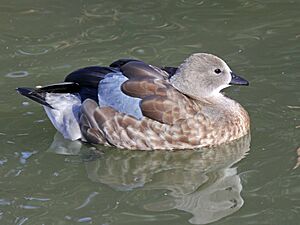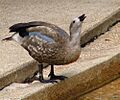Blue-winged goose facts for kids
Quick facts for kids Blue-winged goose |
|
|---|---|
 |
|
| At Sylvan Heights Waterfowl Park | |
| Conservation status | |
| Scientific classification | |
| Genus: |
Cyanochen
|
| Species: |
cyanoptera
|
| Synonyms | |
|
Cyanochen cyanopterus (Rüppell, 1845) |
|
The blue-winged goose (Cyanochen cyanoptera) is a special type of waterfowl that lives only in Ethiopia. It's the only bird in its group, called Cyanochen. This goose is known for its unique blue wings, which you can see when it flies.
Contents
What Makes This Goose Special?
The blue-winged goose is a medium-sized bird, about 70 centimeters (27 inches) long. It has a stocky body and is mostly grey-brown. Its head and upper neck are a bit lighter in color. You can spot its small black bill and black legs.
When it's standing, the goose looks quite plain, mostly gray and dirty white. But when it takes flight, you'll see a beautiful pale blue color on the front part of its wings! Both male and female geese look similar, but young birds are not as brightly colored. Their feathers are thick and loose, almost like fur. This helps them stay warm in the cold mountains of Ethiopia.
How Does It Sound?
The blue-winged goose is a very quiet bird. Unlike other geese that honk or cackle, both male and female blue-winged geese make a soft whistling sound.
Where Do Blue-Winged Geese Live?
These geese live in different watery places in Ethiopia. Their favorite spots include:
- Rivers
- Freshwater lakes
- Swamps
- Freshwater marshes
- Areas where water is stored
- High-altitude shrubland or grassland areas
They prefer places that are high up in the mountains, where it can get quite cold.
How Do Blue-Winged Geese Behave?
The blue-winged goose spends its time eating grass, which is called grazing. It seems to do most of its eating at night. During the day, it often rests.
Even though it can swim and fly well, this goose usually prefers to stay on land. It's not very shy and can be quite easy to get close to. When it's not breeding, blue-winged geese often gather together in groups.
Breeding and Eggs
These geese build their nests near mountain lakes and streams. They are thought to make a cozy nest lined with grass. A female blue-winged goose usually lays about 6 to 7 eggs.
Is This Goose in Danger?
The blue-winged goose is facing some challenges. Its home is being lost because of habitat loss. People also sometimes trap them for food. Dry weather, or drought, can also be a problem for them.
Because of these threats, the blue-winged goose is listed as a "Near Threatened" species. This means it could become endangered if things don't improve.
Images for kids





